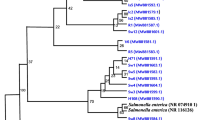Abstract
Spread of multidrug-resistant strains of Salmonella enterica serotype Typhimurium (S. typhimurium) is increasingly reported worldwide. The presence of a pattern of resistance to ampicillin, chloramphenicol, streptomycin, sulfonamides and tetracycline (ACSSuT), in some cases associated to trimethoprim and infrequently to quinolones, is of particular concern. This resistance pattern appears to be chromosomally encoded and, in most epidemiological studies, closely related to definitive type 104 (DT104).
In southern Italy multidrug-resistant isolates of S. typhimurium had been identified since 1980, but only during 1992 S. typhimurium strains with chromosomally encoded drug resistance were first isolated from domestic animals.
One hundred fifty-five isolates – 52.5% of the multidrug-resistant strains identified in the years 1992–1997 – were submitted to phage typing and plasmid profile analysis. Ribotyping was also performed in comparison with a random sample of 150 strains susceptible or resistant to three or less antibiotics identified in the same interval of time.
Four ribotypes (RTs) -1, 5, 8, and 48 – included approximately 90% of the multiresistant strains, RT8 accounting for 61.2%. Phage type (PT) 193 is the most prevalent phage type.
Phage typing and ribotyping suggest that few bacterial clones are involved in spread of multi- drug-resistant S. typhimurium strains in southern Italy.
Similar content being viewed by others
References
Glynn MK, Bopp C, Dewitt W, et al. Emergence of multidrug-resistant Salmonella enterica serotype Typhimurium DT104 infections in the United States. New Engl J Med 1998; 338: 1333–1337.
Wall PG, Morgan D, Lamden K, et al. A case control study of infection with an epidemic strain of multiresistant Salmonella typhimurium DT104 in England and Wales. Commun Dis Rep CDR Rev 1994; 11: R130–135.
Schmieger H, Schicklmaier P. Transduction of multiple drug resistance of Salmonella enterica serovar Typhimurium DT104. FEMS Microbiol Lett 1999; 170: 251–256.
Threlfall EJ, Ward LR, Rowe B. Increasing incidence of resistance to trimethoprim and ciprofloxacin in endemic Salmonella typhimurium in England and Wales. Eurosurveillance 1997; 2: 81–84.
Besser TE, Gay CC, Gay JM, et al. Salmonellosis associated with S. typhimurium DT104 in the USA. Vet Rec 1997; 140: 75.
Fone DL, Barker RM. Association between human and farm animal infections with Salmonella typhimurium DT104 in Herefordshire. Commun Dis Rep CDR Rev 1994; 4: R136–140.
Wray C, McLaren IM, Jones YE. The epidemiology of Salmonella typhimurium in cattle: plasmid profile analysis of definitive phage type (DT) 204c. J Med Microbiol 1998; 47: 483–487.
Martini A, Filetici E, Fantasia M. Epidemiological markers of Salmonella typhimurium isolates in Rome. J Med Microbiol 1992; 37: 104–108.
Guerra B, Landeras E, Gonzalez-Hevia MA, Mendoza MC. A three-way ribotyping scheme for Salmonella serotype Typhimurium and its usefulness for phylogenetic and epidemiological purposes. J Med Microbiol 1997; 46: 307–313.
Nastasi A, Mammina C, Villafrate MR. Epidemiology of Salmonella typhimurium: ribosomal DNA analysis of strains from human and animal sources. Epidemiol Infect 1993; 110: 553–565.
Bauer AW, Kirby WMM, Sherris JC, Turck M. Antibiotic susceptibility testing by a standardized single disk method. Am J Clin Pathol 1966; 45: 493–497.
Datta N. Transmissible drug-resistance in an epidemic strain of Salmonella typhimurium. J Hyg 1962; 60: 301–310.
Anderson ES, Ward LR, de Saxe MJ, de SA JD. Bacteriophage typing designations of Salmonella typhimurium. J Hyg (Lond) 1977; 78: 297–300.
Birnboim HC, Doly J. A rapid alkaline extraction procedure for screening recombinant plasmid DNA. Nucl Acids Res 1979; 7: 1513–1523.
Sambrook J, Fritsch EF, Maniatis T. Molecular cloning: a laboratory manual, 2nd edn. Cold Spring Harbor, NY, Cold Spring Harbor Laboratory Press, 1989.
Jones GW, Rabert DK, Svinarich DM, Withfield HJ. Association of adhesive, invasive and virulent phenotypes of Salmonella typhimurium with autonomous 60-megadaltons plasmids. Infect Immun 1982; 38: 476–486.
Casin I, Breuil J, Brisabois A, Moury F, Grimont F, Collatz E. Multidrug-resistant human and animal Salmonella typhimurium isolates in France belong predominantly to a DT104 clone with the chromosome-and integron-encoded ?-lactamase PSE-1. J Infect Dis 1999; 179: 1173–1182.
Milleman Y, Lesage MC, Chaslus-Dancla E, Lafont JP. Value of plasmid profiling, ribotyping, and detection of IS200 for tracing avian isolates of Salmonella typhimurium and S. enteritidis. J Clin Microbiol 1995; 33: 173–179.
Author information
Authors and Affiliations
Rights and permissions
About this article
Cite this article
Nastasi, A., Mammina, C. Surveillance of multidrug-resistant strains of Salmonella enterica serotype Typhimurium in southern Italy in the years 1992–1997. Eur J Epidemiol 16, 135–139 (2000). https://doi.org/10.1023/A:1007680500678
Issue Date:
DOI: https://doi.org/10.1023/A:1007680500678




